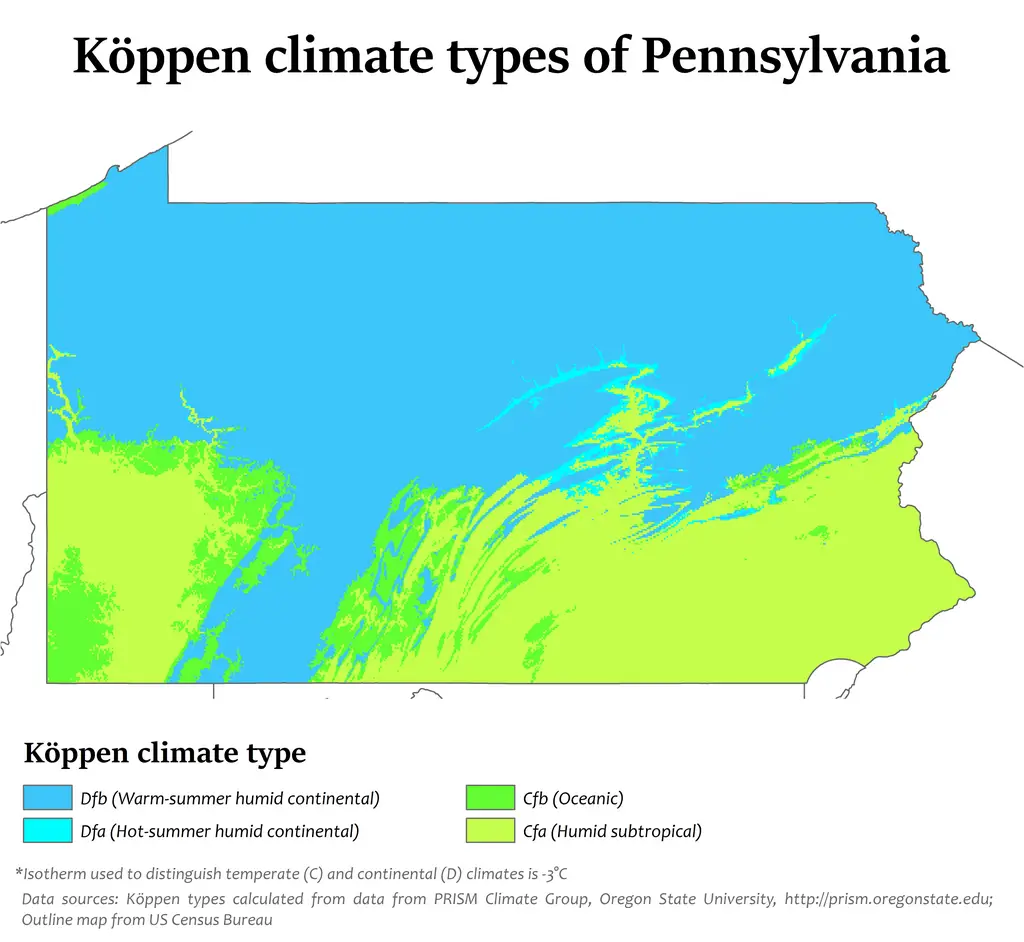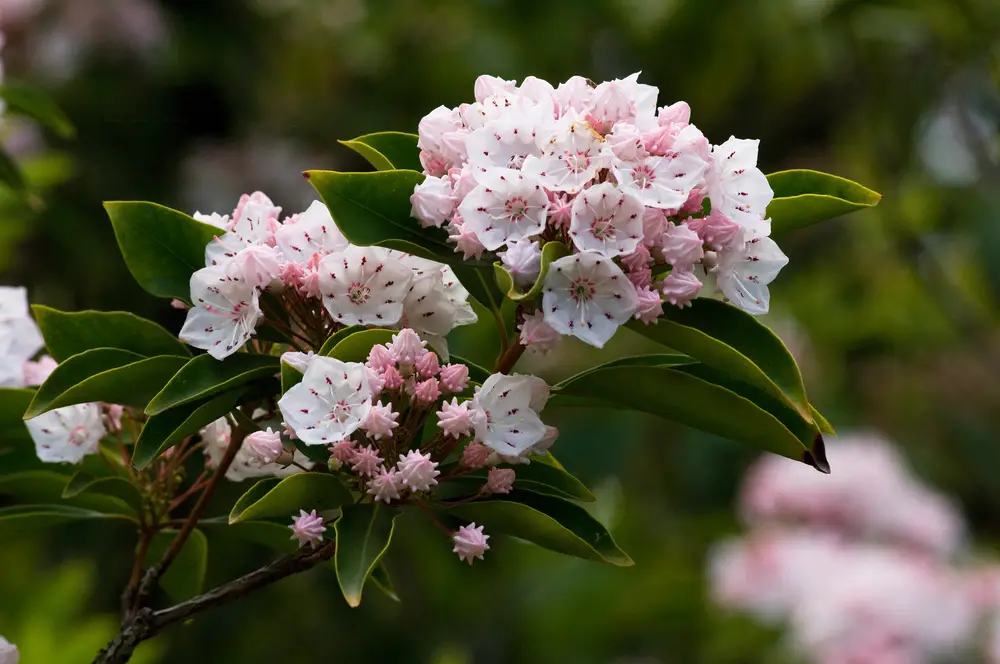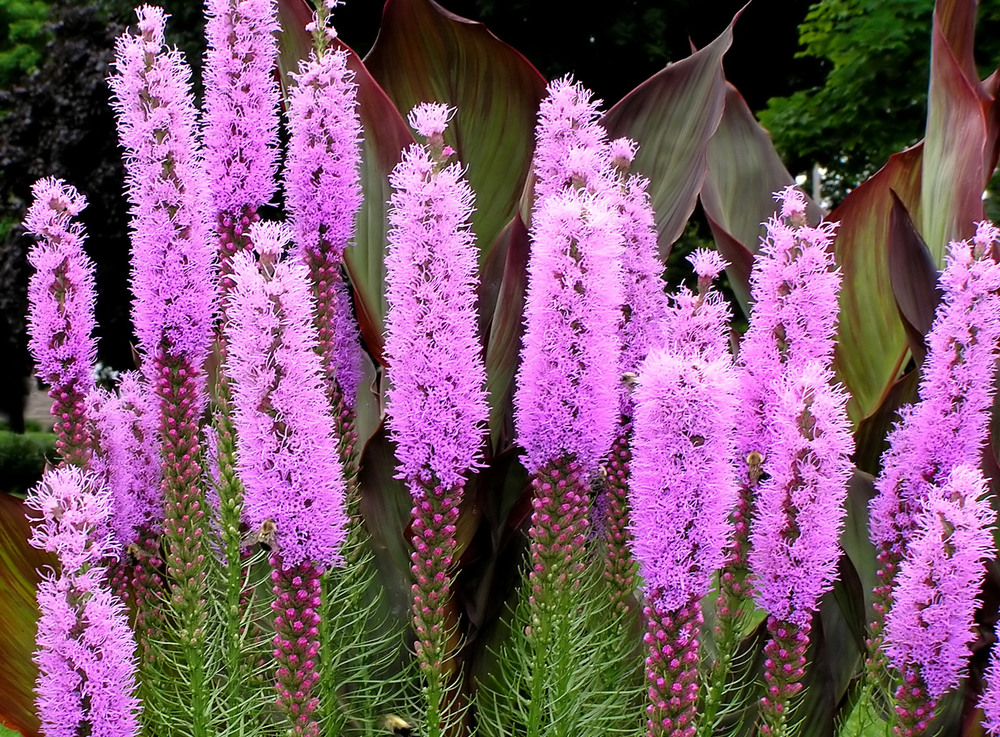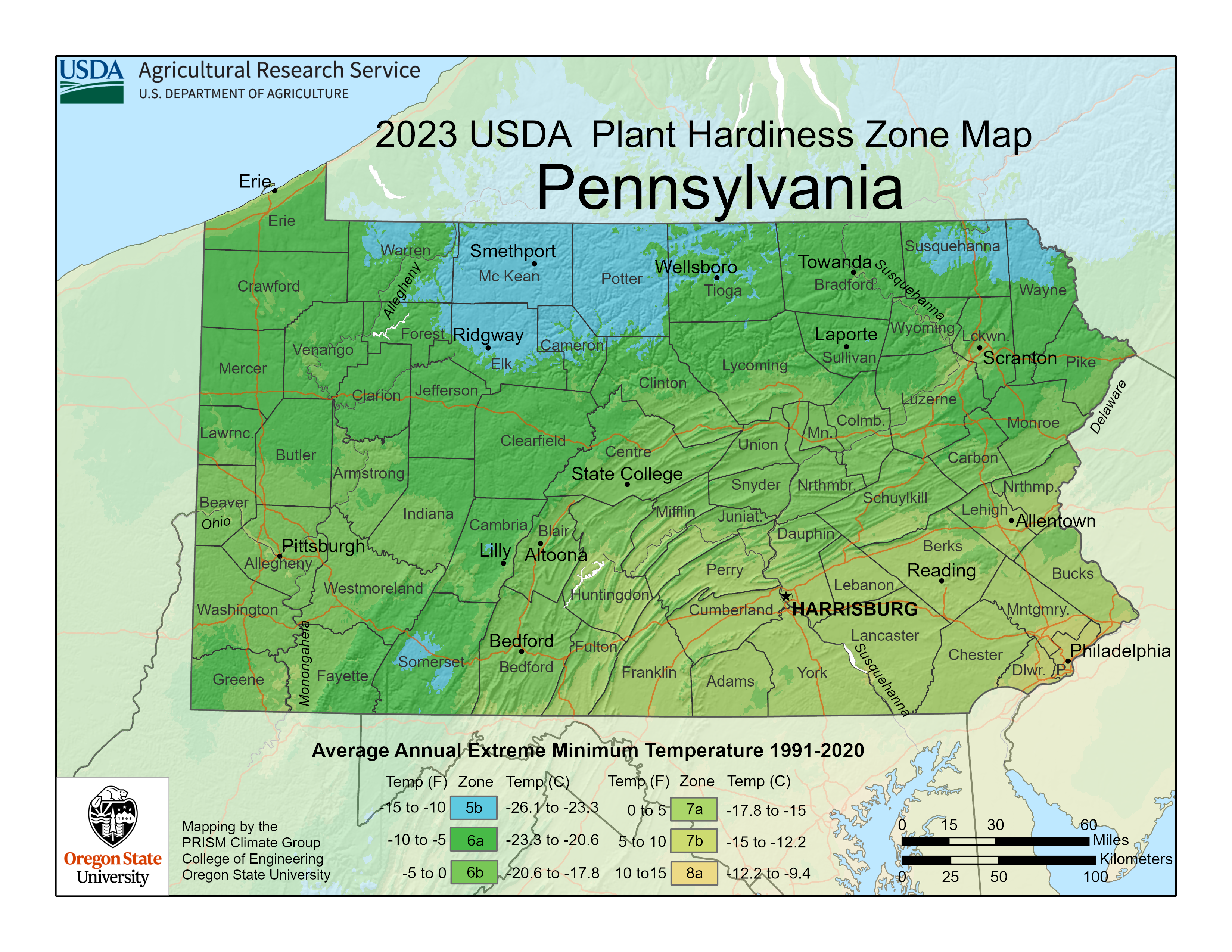Pennsylvania Plant Hardiness Zones
| USDA Hardiness Zone | Average Minimum Extreme Winter Temperature Range Fahrenheit (°F)Celsius (°C) | Average Last Frost Date Range In Spring (Beginning Of The Growing Season) | Average First Frost Date Range In Autumn (End Of The Growing Season) |
|---|---|---|---|
| 5b | -15°F to -10°F -26.1°C to -23.3°C | Early to mid-May | Mid-to-late October |
| 6a | -10°F to -5°F -23.3°C to -20.6°C | Late April | Late October |
| 6b | -5°F to 0°F -20.6 °C to -17.8 °C | Late April | Late October |
| 7a | 0°F to 5°F -17.8 °C to -15 °C | Late March to early April | Early to mid-November |
| 7b | 5°F to 10°F -15 °C to -12.2 °C | Late March to early April | Early to mid-November |
| 8a | 10°F to 15°F -12.2 °C to -9.4 °C | N/A | N/A |
Pennsylvania Growing Conditions
General Climate

Pennsylvania’s climate is mostly humid continental, but some microclimates also exist. This varies due to its proximity to mountains, the Atlantic Ocean, Lake Erie, and the Piedmont and Allegheny Plateaus.
The Southeastern Coastal Plain and Piedmont Plateau is a transition zone between humid continental and humid subtropical climates. Long, warm (sometimes hot) summers and mild winters are common. The Chesapeake Bay and Atlantic Ocean moderate the area’s climate.
The Ridge and Valley Province has a humid continental climate. The mountain and valley geography its name describes creates conditions that are more variable than other parts of the state. Growing seasons are also shorter.
The Allegheny Plateau sees more precipitation than other parts. The northern part of this region (due to latitude and elevation) is the coldest in the state.
Though not a particularly large area, the Lake Erie Plain region is distinct and conducive to growing fruits and vegetables as the lake moderates weather, amplifying warmth in the spring and delaying cold in its immediate vicinity in the autumn.
Microclimates
USDA plant hardiness zones are an important starting point for your garden, but you’ll also need to consider microclimates.
Microclimates are areas where specific conditions create a climate different from the climate they’re situated in.
Buildings, fences, paved areas, or short hills and valleys can create these microclimates.
They can be as small as a space in your backyard or as large as a city.
In other words, learn about your local conditions from local experts to see if your garden falls into a microclimate.
Extreme Weather
Extreme weather events compound problematic environmental conditions, often creating challenges for plant growth during the specific season they occur in and sometimes in subsequent years.
Similar to other states in the northeastern United States, Pennsylvania is getting warmer and wetter.
Extreme Heat Events
Pennsylvania routinely sees more hot days than 50 years ago, and the effects are widespread.
Heat stress can be exceptionally damaging to summer flowering crops. Increased temperatures can exacerbate dry conditions or intensify precipitation events.
During prolonged heat, water your plants well at the beginning of each day. You may need to water again in the evening. Watering early and late helps prevent evaporation in the heat of the day.
Adding a layer of mulch around the base of plants will help retain moisture between waterings.
Thunderstorms
Thunderstorms with damaging wind and excessive precipitation (including hail) are becoming more regular in Pennsylvania. The thunderstorm season runs through the spring and summer and storms can quickly escalate even to tornado levels.
You can stake or use trellises to offer vertical-growing plants support and some degree of protection from wind.
Once storms have passed, remove any damaged plant materials. Continue to monitor progress and be patient – you won’t know how plants will recover for a few days.
Flooding
Pennsylvania is a water-rich state. As a result, you’re routinely tasked with managing abrupt surges of freshwater that can result in floods.
Floods can break or drown your plants if covered in standing water. Standing water also leaves little to no room for air in your soil.
As such, you may want to:
- Garden in raised beds, which are less likely to be affected by floods
- Ensure you’ve planned and created appropriate drainage in your gardens (and yards, in general)
- Incorporate rain gardens into their landscaping plans
- Plant in containers, which you can move at will
Growing Season
Pennsylvania’s growing season is variable and generally affected by latitude and altitude. Generally speaking, the lowlands’ growing season ranges from the end of March or the beginning of April until late October or early November. The highlands’ growing season begins in May and ends in early to mid-October.
Pennsylvania Gardening Tips

Rain Gardens
Rain gardens are human-made depressions typically dug in naturally low spots in a landscape. They funnel and contain runoff water, preventing excess amounts from releasing into the stormwater systems when they are already full (such as during massive precipitation events).
Rain gardens require plants capable of surviving (and, in some cases, thriving) in such wet conditions. These plants help manage standing water by absorbing some of it through their natural life processes.
Plant suggestions for use in a rain garden include the following:
- Blue lobelia
- Marsh marigold
- Bunchberry
- Cardinal flower
- Fox sedge
- Rose mallow
- Button bush
- Egyptian papyrus grass
Choose The Right Plants And Plant At The Right Time
Native species are always the best choices for any environment as they are the plants most adapted to their environmental climatic conditions and soils.
If you live in Pennsylvania’s zone 5 growing regions, you will want to start tender varieties indoors and transplant them once outdoor temperatures have warmed. In spring and early autumn, you can plant cold-tolerant plants several weeks or months earlier than the first and last frost dates.
During the spring in Pennsylvania zones 6, 7, and 8, you’ll find success planting quick-growing varieties that prefer the cold of spring and autumn, such as lettuce, kale, peas, and broccoli.
These cold-tolerant crops thrive in the moderate temperatures of spring. Their fast-growing period means once temperatures begin to rise, you can harvest and replace them with plants that thrive in the Pennsylvania heat, such as squash, sweet and spicy peppers, beans, tomatoes, corn, and eggplant.
To grow these heat-loving crops successfully, seed them indoors in March. Once temperatures increase to at least 50°F (10°C), you can transition plants to outdoor conditions (adding an hour or two longer every couple of days) and eventually transplant them to your garden.
Consult With Local Professionals
Consulting with local gardening professionals allows you to benefit from their experience with your area’s conditions, the plants that do well there, and overall best practices.
Pennsylvania Plant Suggestions

Trees
- Eastern Hemlock (Tsuga canadensis)
- Balsam Fir (Abies balsamea)
- Silver Maple (Acer saccharinum)
Shrubs
- Wild Red Currant (Ribes trieste)
- Eastern Redbud (Cercis canadensis)
- Ninebark (Physocarpus opulifolius)
Flowers
- Marsh Blazing Star (Liatris spicata)
- Blue Lobelia (Lobelia siphilitica)
- Virginia Bluebells (Mertensia virginica)
Vegetables
- Tomatoes (Solanum lycopersicum)
- Carrots (Daucus carota)
- Cabbage (Brassica oleracea)
Herbs
- Peppermint (Mentha spicata)
- Tulsi (Ocimum tenuiflorum)
- Comfrey (Symphytum officinale)
Spices
- Anise (Pimpinella anisum)
- Caraway (Carum carvi)
- Coriander (Coriandrum sativum)
Fruits
- Apples (Malus domestica)
- Cherries (Prunus avium)
- Blueberries (Vaccinium myrtillus)
Succulents
- Hens And Chicks (Sempervivum tectorum)
- Adam’s Needle (Yucca filamentosa)
- Low Prickly Pear (Opuntia humifusa)
Disclaimer
Any of the above can change and is not exhaustive.
Treat anything above like a good starter guide. Then use that as a foundation as you consult with local gardeners, professionals, forecasts, guides, and organizations.

